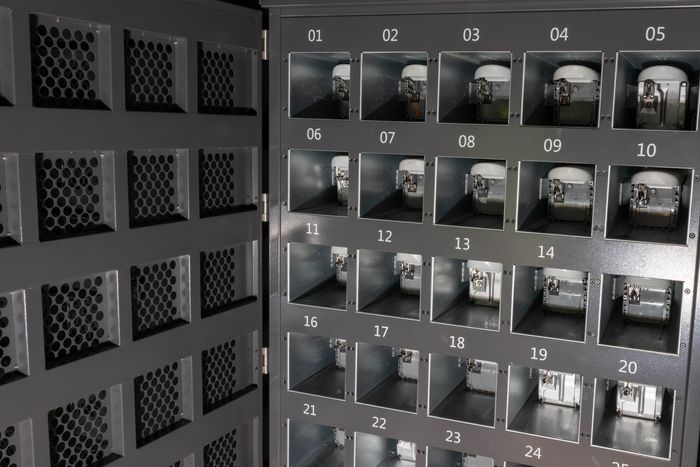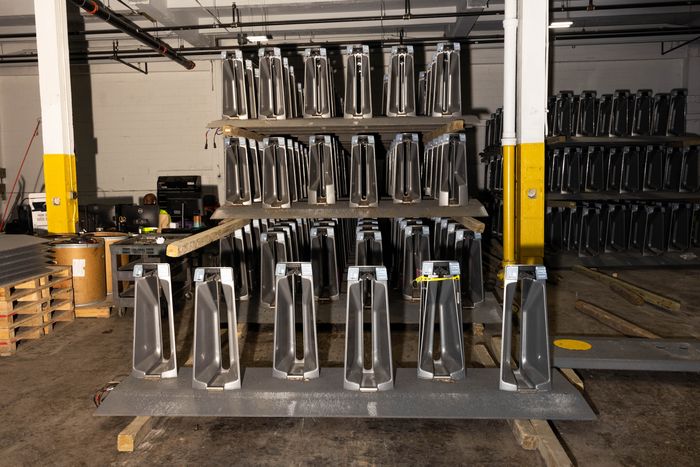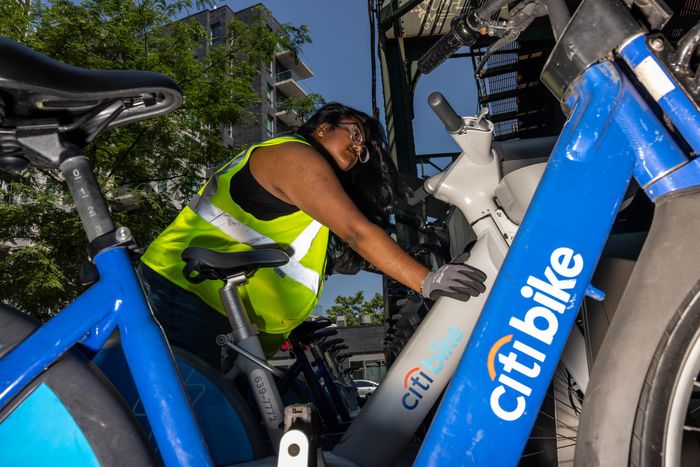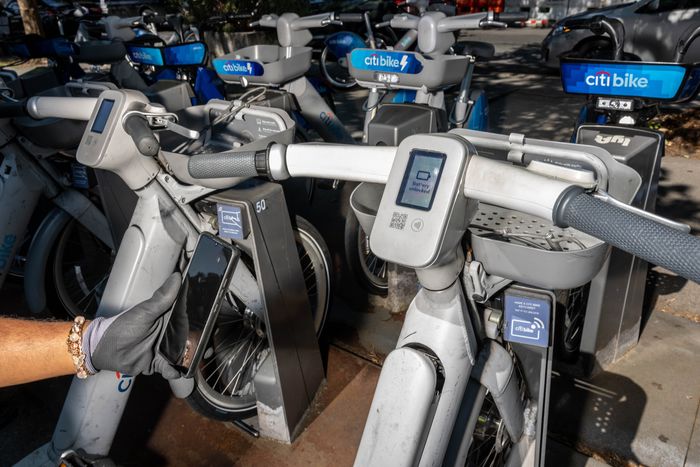The Citi Bike Battery Crew Racing to Charge 15,000 E-Bikes


Citi Bike’s cargo vans are specially equipped to swap up to 72 batteries from one truckload.
Photo: Alex Kent
No one approaching a Citi Bike dock wants to see the red light. It signals one of many possible mechanical misfortunes: The pedals are jammed; the battery is dead; the brakes are corroded; the dock is offline; or, very rarely, the entire system is down (which did happen in June, lasting all of two hours). It’s come to feel routine — scanning the row of docks for a good one.
This is when most riders will either find another bike or move on. But the system has flagged the malfunction and a mostly invisible workforce of bike mechanics, drivers, “rebalancers” (who redistribute bikes among stations), maintenance crews, and operations managers has been mobilized to address it. Now that Citi Bike’s peak season has begun, that’s more than 1,000 people who are on call in a 24/7, year-round operation to keep one of the world’s largest bike-share networks running. In June alone, the average is 165,000 rides a day, and the teams at Citi Bike and Lyft, which owns the bike-share system, believe it will hit 200,000 before the year is out.
Part of that boom has come from the number of riders who want the Cosmo, the silver e-bike that has replaced many of the blue first-generation e-bikes. Citi Bike has upped that supply accordingly after the city lifted the cap on them last November. Now a total of 15,000 pedal-assist bikes (of the 40,000-total fleet) make up 65 percent of Citi Bike’s trips. Even Lyft didn’t project this scale of demand, and it’s figuring out how to streamline all the charging and maintenance.
That’s a challenge because — and a surprising number of users don’t realize this — the streetside docks don’t charge bikes (apart from two pilot sites that just launched in May, that is). Nearly every depleted battery, up to 5,000 a day, needs to be transported to a Long Island City warehouse, plugged in, and then ferried back out to stations that now stretch from Van Cortlandt Park to Citi Field and all the way down to Sunset Park. Doing that requires a crew of 170 people, four shifts, and 67 specially equipped cargo vans.
The cabinets at the Long Island City warehouse charge up to 5,000 batteries a day.
Photo: Alex Kent
Citi Bike’s warehouse in Queens also holds dozens of docks in need of repair.
Photo: Alex Kent
All of this, in practice, feels surprisingly low-tech. I was invited to tag along one morning to observe the shuffle. At the warehouses, drivers unload dead batteries and test each one. A diagnostics test flashes purple if a battery is damaged, or red if it’s dead for good. “We’re very conservative, just given the concerns over safety,” said Patrick Knoth, Citi Bike’s general manager. “So even if it’s slightly damaged, we recycle it.”
Once cleared, the batteries are inserted into a series of “charging cabinets” in the warehouse which resemble freezers for plutonium, or equipment you might expect to see in a sci-fi movie. They can charge up to 30 batteries at a given time, and a fully depleted one takes about six hours to get to 100 percent. But this does not include the batteries of the first-gen e-bikes, which are not compatible with the cabinets; instead, they sit on a shelf connected to wires and take longer to charge. They also lack sensors, so it’s tough to tell what’s happening once they leave the warehouse, and Citi Bike expects to take them out of service for good by late July. “I think we’re going to have a retirement party when they’re gone,” said Allison Abbott, a regional general manager for Motivate, the company that operates Citi Bike. Charged batteries are then loaded into the trunk of cargo vans, the newest of which can hold 72 batteries each. Each carload takes about four hours to distribute.
Bibi Dhanraj, an operations manager for Motivate, swapping out batteries in Long Island City.
Photo: Alex Kent
As a morning shift of drivers left the warehouse, Bibi Dhanraj, an operations manager with Motivate, showed me an app on her phone called Fieldwork. The software allows her to see where each driver is located along their route, which is generated for them by an algorithm, refined in the last year, that takes into account traffic and the number of batteries needed along their path. I spotted a few dots on the map indicating the location of bikes, far from the Citi Bike service area — closer to Long Island than Manhattan. “Those are the ones left on the side of a road,” she explained. “You wouldn’t believe where they show up sometimes.”
Soon, Dhanraj was getting ready to swap some batteries herself. We tailed her by bike to the first station on Jackson Avenue. She double-parked and lugged out two, and moved to the first bike her phone app identified for her. She tapped her phone on its center console, which detached the battery. Old one out, new one in. The whole exchange takes less than 30 seconds.
Crew members use a smartphone app to swap out batteries.
Photo: Alex Kent
This fast-moving logistics chain has allowed Citi Bike to speed up the rate of refreshed bikes, a problem that was much more endemic last year, when about half of all e-bikes were losing their charge within 24 hours. Today, that share is just 4 percent.
But most of the day, Dhanraj is troubleshooting on the phone. Drivers call in regularly about connectivity issues, longer-than-expected travel times, parking issues, or questions from curious (and sometimes frustrated) riders they encounter while swapping. But sometimes it’s a particular brand of New York City chaos. “I got a call recently that a station was completely covered in garbage. The driver couldn’t even get to the bikes, it was so bad,” she told me.
If all goes according to plan, this daily race should get less frantic, as Citi Bike begins to electrify its docks. The company has projected that doing so at just 20 percent of its stations would replace 90 percent of swaps. We visited one of the two pilot sites at the corner of Manhattan and Meserole Avenue in Greenpoint. (The other is in front of Lyft’s Midtown office.) Both sites are on the sidewalk for a reason: Ripping up a street can cost a small fortune, and it was easier to get ConEd, the Department of Transportation, and other agencies to green-light a sidewalk renovation for the first go.
It’s not easy to tell that this station is connected to a power grid underground, minus subtle differences. One helpful change is that users can tap their fob on the new docks rather than insert it.
For a charging station to work, it will need a “Goldilocks of factors” working in its favor, Knoth said. It has to be frequented enough that it’ll make a dent in the fleet, but not too busy that the bikes end up leaving with only a partial charge. (A full charge takes about four to six hours, like an EV.) Citi Bike is pitching more potential sites to NYCDOT, which will let it know if a link to the grid is too far off, or a water main stands in its way. Citi Bike is also exploring funding opportunities to pay for it all.
Knoth said he hopes to have ten charging stations built by the end of the year. I asked what that meant for the battery cavalry, and all of the other people supporting that around-the-clock process.
“We’ll find work for them,” replied Knoth. Crew members will need to be retrained in maintaining the charging stations, which is arguably more complex and specialized than battery swaps. And with more power comes a lot more bikes zipping around, and more flat tires, more cracked consoles, more broken baskets.
In other words: more red lights. “There’s plenty to do.”
See All
Source link








